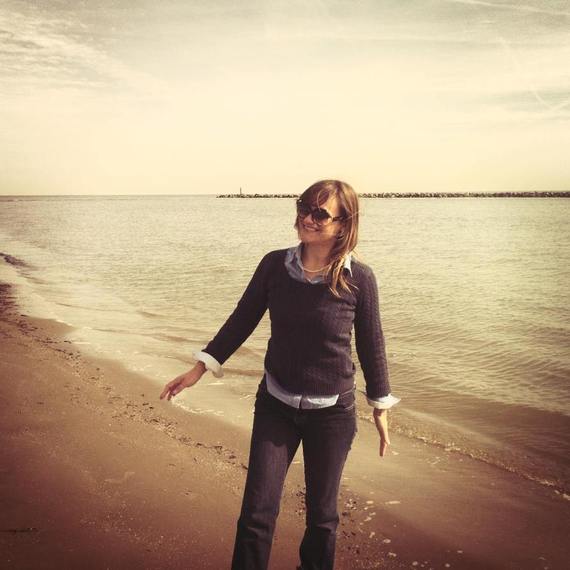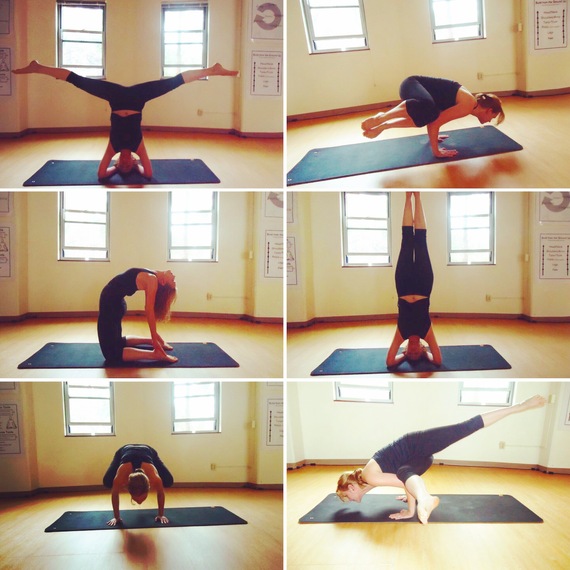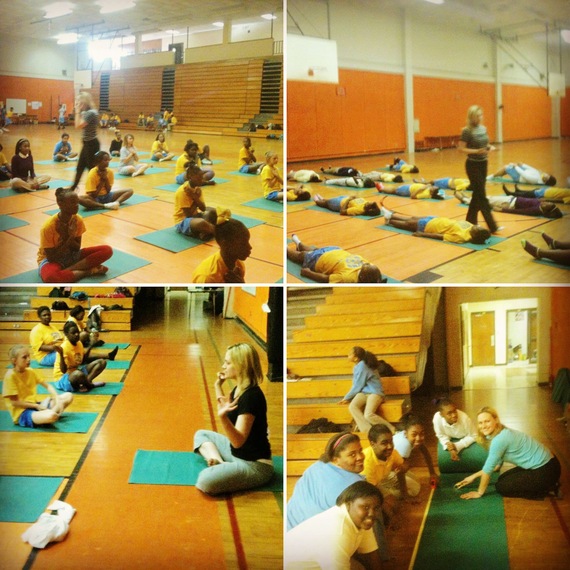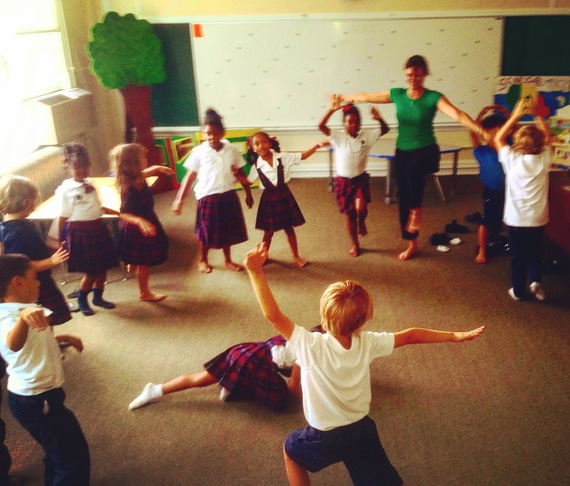Instagram, Snapchat, Facebook, Twitter. Students are online more than ever. Nine in 10 teens report going online every day, nearly a quarter say they are online "almost constantly," and more than 70 percent have access to smartphones, according to a 2015 Pew Research Center survey. And teens are not casual web surfers. Among adolescents who own cell phones, 41 percent admitted that they felt "addicted" to their devices in a 2012 Common Sense Media study.
In this hyper-connected, on-line all-the-time culture, it has never been more important to disengage and slow down. Adults have been doing it for years -- through yoga and the increasingly popular practice of mindfulness, which is generally described as the state of being attentive to the present moment. A litany of studies has credited yoga and mindfulness with reducing stress, calming nerves and anxiety, increasing focus and even improving efficiency and concentration at work.
You don't have to be an adult, however, to reap the benefits of mindfulness. Research suggests that teaching children to disconnect though mindfulness meditation, breathing exercises and yoga can help them in the same way it benefits adults. Studies also show that mindfulness can alleviate teen depression and anxiety, enhance sleep quality, and even improve self-esteem.
High schoolers participating in The Peaceful Child program in New Orleans share their thoughts on yoga and mindfulness.
Across the country, yoga and guided mindfulness meditation programs are already serving students from pre-K to high-school. Rebecca Kastl is the head of one such program, The Peaceful Child. Based in New Orleans, Kastl's non-profit offers yoga and mindfulness classes for children and also trains teachers to take the practice back to their classrooms. Kastl, who holds a master's degree from the Teachers College of Columbia University, has taught yoga and mindful meditation to hundreds of children in public, private and charter schools. What follows is our conversation on yoga, mindfulness and teaching hyper-connected kids to hear their "own inner voice over the noise of the world."
MG: When did you first start practicing yoga and mindfulness?
RK: I was in high school in New Orleans. One day a friend told me about a lady who was teaching yoga. He said she'd been to India and learned ancient techniques. The style is called Ashtanga Yoga and is taught in the classical Indian style. The studio was not even yet a studio, but was rented space. It was a corner entry with bare floors and an industrial feel ... We learned the First Series. I remember learning all the pose names in Sanskrit, learning about Ujjayi breathing, the drishti (eye gaze), and that it felt very strict. When we did seated-forward bends, our teacher laid on our backs and pushed us all the way forward. They still do this now; it was just the first time I'd experienced it. I also remember being taught how to balance in crow pose. We were told how much to turn our feet out, which exact way to move our hands, and it was very precise. In Ashtanga you are given new poses as you master the ones before them. I've been doing these poses in this order for almost 20 years. It becomes a rhythm after a while.
MG: How did yoga and mindfulness help you as a high schooler?
RK: I was stressed out as a teenager. Yoga helped me deal with anxiety. I remember sometimes at night I would envision the poses I'd learned as I fell asleep, and it helped me rest more peacefully.
MG: What are the biggest misconceptions about yoga?
RK: There are so many. One is that it's just an exercise thing. Yoga is rooted in mindfulness exercise as well. Yoga actually means "to meld together the mind and body." I have also heard people who are very religious express concerns-- but yoga doesn't have to be religious or spiritual. Another misconception is that yoga for cute, skinny white girls. But yoga really is for everyone, every shape, size, and color. That's what I love about teaching in New Orleans; we have a diverse community practicing here.
MG: You were born and raised in New Orleans, and endured Hurricane Katrina back in 2005. How did yoga help you cope with such an anxiety-producing disaster?
RK: Katrina was probably the most stressful and scariest thing I've ever been through. Yoga helped me a lot during that time. This past month was the ten-year anniversary of Katrina. It was an emotional time for a lot of my friends and family, and for me. I've been really sad. I was actually at school in New York during the storm. Even there the yoga studios were so welcoming; they took me in. Most of my friends evacuated from New Orleans. But some didn't, like my dad. I didn't hear from him for a whole week. We didn't even know if he was alive. A lot of people left and were too traumatized to come back. After the storm, adults didn't know how to cope, let alone how to help their kids. Many of my students today were little when Katrina hit. I pray that they are able to get the help they need to deal with the long-term trauma. I give them all the love I have to give every day.
MG: What inspired you to launch a program to introduce yoga and mindfulness to students?
RK: I started the Peaceful Child in 2014 to bring yoga and mindfulness to students in New Orleans, to share the things that really changed my life for the better in a positive way with children in my city who may be suffering, or who may need tools they haven't been given. It's also fun!
MG: In your experience, how do students benefit when they disconnect from technology? Why is it important to take a step back from such connectedness?
RK: Students do spend a lot of time online, connecting with social media, and on their phones. I do too. A big part of why disconnecting is important is to allow one's heart and mind to rest, and to allow oneself to hear one's own inner voice over the noise of the world. The noise is so much closer with all of the media at our fingertips. When you turn it off, you can get back into your own balance and your own rhythm.
MG: What surprised you most about teaching yoga and mindfulness to young students? Do you think that even the little ones benefit from disconnecting from technology as well?
I have been surprised at how easily the young ones can meditate. They seem to have an easier time with it than most adults. They say things like, "I feel like I'm floating!" They are also really flexible, which is to be expected. In my children's classes I'll have students teach each other yoga poses, and they can either choose one we've learned, or make up their own pose. At least 80% of the time, when a child chooses to teach their own made up pose, it ends up being a real yoga pose that I've learned in my adult classes. This summer a 9-year old "made up" a more advanced Ashtanga pose called Bhujapidasana. I was impressed!
MG: In what other ways is yoga beneficial for such students, particularly those in high school?
RK: High schoolers today are stressed. Weren't you stressed in high school? So many different things are happening in their lives: testing, bullying. Maybe their parents aren't home or they're fighting or they're abusive. Yoga and mindfulness helps. And one thing I try to remember is how -- whenever I get to really know someone and they open up about their high school experience for the first time -- I always learn about a side of them I'd never known before. Serious things happen in high school that affect your whole life. I look at my students and even if they seem fine on the outside, I know they're going through real issues. We've all been there.
MG: Can you walk me through a yoga class, as though I'm one of your students?
RK: "Welcome to class. Thank you so much for being here. I hope you had a good day! Let's go around the room and share something great that happened to you today. (Students tell stories). Thank you for sharing! Today we will start by continuing to delve more deeply into our breathing. Last week we learned about belly breathing and breathing into our rib cage. This week we will learn about breathing into the top part of our chest, and finally we will combine all of this into what is called the three-part breath, or dirgha breath. Please lay on your backs on your mat, with your knees bent and feet resting on the ground. Place your hands over your belly and breath deeply into your belly, feeling it rise and fall. Take three breaths here, focusing on the expansion of your belly as you breathe. Next, place each hand around the sides of your rib cage, fingers in front and thumbs in back. Take three deep breaths here, filling the sides of your lungs with air, and feeling them expand outward and fall inward on the exhale. Lastly, let's take our hands and place them over our sternum, breathing into the top part of our chest, and feeling the upper parts of our lungs fill with air on each inhale. After three deep breaths here, we will combine all of this into our three-part or dirgha breath..." (Class continues with warm-ups, yoga poses, and a final meditation).
MG: I feel more relaxed just listening. How long is a typical class?
RK: About 30-45 minutes. It goes by quickly; the kids pick it up fast. And it's funny, I ask the high schoolers to name something great that happened in their day, and they usually have a hard time coming up with something. It takes some time. But I also teach very little kids, and they always have things to say right away! Even 3-4 year olds. The older we get, the more stressed out and overwhelmed we become with the day-to-day. So I like to take the time with older students to pause and reflect on something that they're grateful for.
MG: Are most students excited about yoga lessons, or do you have to convince them to participate?
RK: A lot are excited about it, but a few don't like it. They'd rather run or play tennis, which is completely fine. I would say 85-90% seem to really enjoy yoga class.
MG: Have you had a particular student get excited about yoga in ways you didn't expect?
RK: I had a middle school student who was quiet, didn't open up to a lot of people. But she loved yoga! She would come to my room, even get out of other classes to come by. I ended up giving her yoga books, and we would talk about them after school. At the end of the summer, she actually texted me saying that she'd been doing yoga all summer, and learned that her Hindu mother (who had left her family) also loved yoga. I felt like I had reconnected her to her roots in a way. It was special.
MG: Have you had parents or teachers comment on a student's improvement in the classroom as a result of yoga?
RK: I've had students tell me they felt better after yoga classes, that they were more relaxed and better able to focus in school. But I think that yoga is a long-term grow for a lot of people. It can take months to notice a difference sometimes. Down the road I'd like to do measured studies to see if test scores improve with my students, but so far I've just heard their stories of improvement.
MG: For teachers who'd like to bring yoga or mindfulness exercises to their students for the first time, can you recommend some of your favorite online resources?
RK: I recently learned about Go Noodle, which has short online videos to get kids moving, including yoga videos, many of which are free. I also like Cosmic Kids, and know several parents who recommend these videos, which you can find on YouTube. For teachers who'd like to practice on their own, I'd recommend checking out My Yoga Works.
MG: What advice would you offer a yoga newbie -- whether student, teacher or otherwise -- who'd like to attend class for the first time?
RK: Go try a few different ones, but stick with the teacher you like best. These days, you don't have to go to an expensive studio. There are so many excellent community yoga classes; you don't have to pay a lot to have a quality experience.
This piece originally appeared on the Young Education Professionals' Recess blog, and has been republished with permission.





